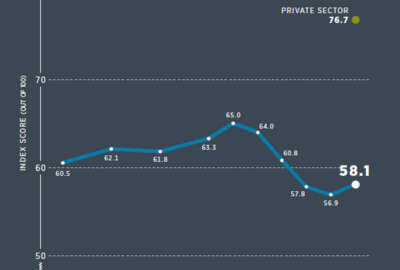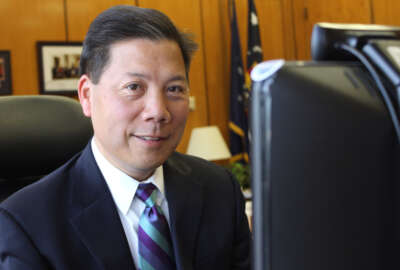
What’s the main culprit behind poor employee engagement? It’s complicated
Members of the House Oversight and Government Reform Subcommittee on Government Operations took the Homeland Security Department to task for six straight years of...
For the fourth consecutive year, NASA topped the list of large agencies with the highest employee engagement on the 2015 Federal Employee Viewpoint Survey. It’s again considered the best agency to work for by the Partnership for Public Service.
Once again, the Homeland Security Department ranked last among large agencies, and its overall engagement scores fell for the sixth year in a row.
But consider the differences.
NASA employs roughly 17,000 employees, said Lauren Leo, he department’s chief human capital officer, during an April 27 hearing on the best and worst places to work in government.
NASA has “a plethora of missions,” Leo said, from putting people into space to researching climate change.
DHS CHCO Angela Bailey said her department has nearly 240,000 employees across 22 component agencies.
“That’s a world of difference than the cohesive mission that helps provide an organizing principle for NASA,” said Rep. Gerry Connolly (D-Va.), the ranking member of the House Oversight and Government Reform Subcommittee on Government Operations.
“DHS has a much more difficult task, from day one,” he added. “That’s not to let anyone off the hook.”
The subcommittee had no simple solution for agencies like DHS, which has consistently struggled with employee engagement and earned low scores on the Federal Employee Viewpoint Survey.
But it agreed that top agency leadership should be held accountable for their plans — and their success — in improving employee engagement and creating a culture of recognition.
Connolly said classifying DHS’ struggles with engagement as a leadership problem is “oversimplifying the issue.”
According to the results of the 2015 FEVS, 50 percent of employees had positive comments about the honesty and integrity of their leadership.
“You have to differentiate between performers and non-performers, people with stellar performance and people with adequate or sub-adequate performance,” Connolly said. “If you treat everybody’s performance the same when it comes to recognition, you are saying to your stellar performers, I can come in early and stay late. I can donate time on the weekends and it doesn’t matter. I’m going to be treated like Harry Houdini there, who is a clock-watcher, shows up at 9, leaves promptly at 5 and doesn’t volunteer for anything.”
Of private sector employees, 73 percent say their managers recognize excellent performance, Connolly said. Roughly 44 percent of public sector employees agree.
According to the 2015 FEVS results, 33 percent of federal employees say their promotions are based on merit.
Bailey said the department is trying to improve. DHS is working with its components to develop specific engagement action plans. It’s also hiring a chief learning and engagement officer, she said.
But some members of the committee aren’t convinced.
“[At] NASA and DOL and HUD, it’s actually working,” Rep. Mick Mulvaney (R-S.C.) said of DHS’ plans to improve engagement. “They made it a priority. Everybody used the words, ‘We’ve had town hall meeting with our employees.’ We get that, and that’s the right thing to do. But our question is, when is it actually going to work?”
After more questioning and more demands for a concrete time frame on DHS’ progress, Bailey said the department “will make incremental improvements beginning this year.”
Specific components within the department, such as the Transportation Security Administration, Customs and Border Protection and Secret Service, have members particularly concerned, subcommitte Chairman Mark Meadows (R-N.C.) said.
“We have to see improvement there,” he said. “We get more whistleblowers and concerns from people out of those particular components under your supervision than any others in the entire federal workforce.”
Bailey said a plan for improving employee engagement and morale within those components is already in the works, and she agreed to submit the department’s ideas to the committee within 120 days.
FEVS fixes
There are some changes the Office of Personnel Management could make with Congress’ help to the Federal Employee Viewpoint Survey, which could help agency leaders better use the information they receive from FEVS results to inform their decision-making on employee engagement, said Max Stier, president and CEO of the Partnership for Public Service.
In particular, agency leaders and Stier suggested OPM find ways to release survey results more quickly. Agencies opened up the FEVS to their employees earlier in April, and the survey will stay open until June. But Stier said the survey doesn’t need to stay open so long.
“The truth of the matter is that you ask someone’s opinion about what could be improved in their agency, and if they don’t see anything done with that opinion for six months or seven months or eight months, that’s a real problem,” he said. “The only way the agencies can actually do anything with this is if the information is turned around a lot of faster.”
He also suggested adding specific regulations that would require OPM to administer the survey every year. Current statute doesn’t require OPM to administer FEVS annually, even though the Obama administration has conducted the survey every year, Stier said.
OPM is also in the process now of rewriting the survey, with plans to scale back the number of questions from 47 to 11.
Stier criticized that plan, arguing that some of the questions OPM wants to eliminate help the Partnership for Public Service determine which agencies have improved the most. The Partnership uses the FEVS results to produce its annual “Best Places to Work” rankings.
But the best guidance for improving employee engagement comes from agencies who share their best practices with each other, he said.
“To my mind everything that should happen in the federal government is happening somewhere, just not in all the places it needs to.”
Copyright © 2025 Federal News Network. All rights reserved. This website is not intended for users located within the European Economic Area.
Nicole Ogrysko is a reporter for Federal News Network focusing on the federal workforce and federal pay and benefits.
Follow @nogryskoWFED




